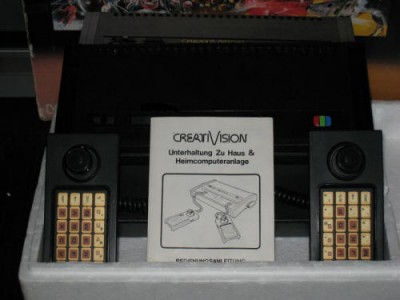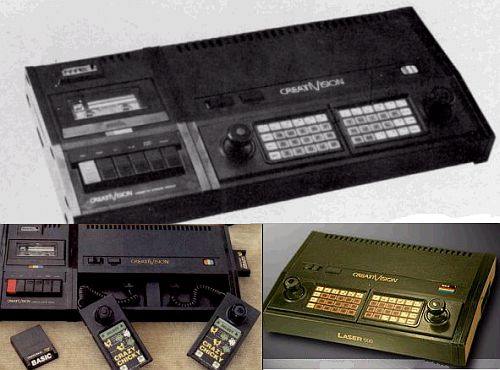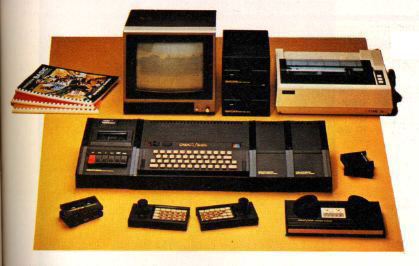
History
Hong Kong, 1981. Electronic game manufacturer VTech attempts to join the home videogaming market by engineering an original system capable of competing against VCS 2600 and Intellivision, which gave Atari and Mattel enormous incomes.
The idea is certainly clever: to offer users what the competitors can't do, that's the chance to programme their own software on a powerful console hardware by expanding it with computer-style periphherals such as keyboard, cassette tape player/recorder, printer, etc. Actually this is not the first "hybrid" computer/console system: American electronic company APF sold their "Imagination Machine" in 1980, a console which could be expanded into a full home computer.
The Creativision project is quite ambitious and VTech engineers decide to endow it with the most recent available hardware such as the Rockwell 6502A microprocessor running at 2 MHz, the Texas Instruments TMS9928/9929 (NTSC/PAL) video display processor managing up to 32 sprites on a 256x192 pixels screen at 16 colours, and a Texas Instruments SND76489 sound generator featuring 3 mono + 1 noise channels. Such a powerful hardware has never been seen on a home videogame and computer system!

Such technological wonder would be very expensive if it's to be manufactured in USA or Europe... but VTech is located in the cheapest Hong Kong, hence costs can be reduced quite a lot. For this reason, the Creativision system is even cheaper than "obsolete" gaming-only systems such as Atari VCS 2600 and Mattel Intellivision.
Hardware is done, so the next step is to write dedicated software. At first, programmers focus their efforts on designing games and... they choose the cheapest way, that's simply "cloning" top sales videogames and then change graphics, sounds and plot - such a procedure is quite common in the 80's, even though it often causes copyright issues!
As a result, we have Police Jump (Donkey Kong), Sonic Invader (Space Invaders), Planet Defender (Defender), Auto Chase (New Rally-X), Mouse Puzzle (Loco-Motion), etc. There's even a Pac-Man clone named Crazy Pucker, which is then retired from shops due to legal issues with Namco, and then reissued with the name of Crazy Chicky: the game now shows a chicken (Pac-Man) who fills a labyrinth with eggs (dots) and foxes (ghosts) trying to eat her.
The Creativision system hits the Hong Kong market in the first half of 1982, and a few months later it's also distributed in Europe (Italy, Germany, Sweden, Austria, Switzerland), South-Africa, Australia and Japan. The "Creativision" name is kept for all markets except Australia and New Zealand, where it's sold through Dick Smith Electronics (a very popular electronic store) with the name of "Wizzard".
All boxes, manuals (in various languages) and accessories are produced in Hong Kong and then provided to distributors, and all consoles do share the same hardware. It's a PAL-only system except the Japanese version (NTSC) which is extremely rare and sought after by collectors.
The complete list of distributors is:
- Italy: Zanussi Elettronica
- Germany: Sanyo Video GmbH
- Austria: Spiel-Sport Stadlbauer
- Sweden: Elof Hansson
- Switzerland: J. M. Rosengarten
- South Africa: Telefunken MicroTek
- Australia & N.Z.: Dick Smith Electronics, Hanimex, Bente International Pty Ltd.
- Japan: Cheryco

Creativision is promoted with a massive advertising campaign, and it's claimed as being the most powerful home gaming computer system on the market. Promo leaflets feature comparisons with other home computers as Commodore Vic-20, Atari 400 and Radio Shack TRS-80 - and of course Creativision is said to be the best of all. A lot of additional peripherals are pictured - many of which are just "mock-ups" and will never be actually produced.
The Wizzard sells very well in Australia, due to the popularity of eccentric billionaire mr. Dick Smith and his electronic supermarkets where the system sells in exclusive right. Dick Smith Electronics not just sells Wizzard systems and software, they also produce new games and utilities, which are sold on tape format for use with the BASIC cartridge and the "Cassette storage module". Very popular books are written by Australian programmers and computing experts, and they sell through the "Dick Smith Publishing" division. Dick Smith sells Wizzard units, software and books from 1982 to 1985, then Bente International becomes a sort of "official" distributor for Creativision (not Wizzard!) stuff in Australia.
What about the Japanese market? Rumours say that Creativision doesn't sell well - maybe there are already lots of other popular home computers, or simply users don't take interest in the cheap hybrid coming from Hong Kong.
A Creativision fan club is set with the name of "Creativision Club" up and is maintained by VTech in Hong Kong. Subscribers pay a yearly fee and receive a periodic newsletter full of infos and news, and get discount to buy software. After the release of the "Laser" home computer series, the fan club name is changed into "Laser Computer Club".
Another importan fan club is based in Melbourne, Australia, and the name is "Wizzdom". Gentleman Barry Klein, the founder, writes a very interesting three-monthly newsletter by using his typewriting machine and his big talent. Contents are pretty "technical" and lots of obscure facts about hardware and software (especially the BASIC cartridge) are unveiled with each issue. Wizzdom lives between January 1984 and the first half of 1985, while the "Laser Computer Club" ceases to exist far after 1986.
Maybe aiming to sell more console units, in the end of 1982/beginning of 1983 VTech decides to re-release Creativision with a new shape and a new name: "Funvision" (also sold as Hanimex "Rameses" and Dick Smith "VZ 2000" in Australia) has the same hardware as before, except the "Creativision" logo which is removed from the console boot sequence (modified BIOS?). The connectors layout is changed, and there are no side panels to be removed in order to connect additional peripherals. Also the cartridge slot is different and doesn't allow the use of the "old" Creativision carts (an early form of country lock).
Later in 1983 VTech gets ready for a new challenge: to go beyond the concept of videogaming home computer, and focus their efforts into the rising home computer market. A new brand of home computers is set, and the name is "Laser". Various models are produced with the names of Laser 100/110, 200/210 and 300, they're all very cheap and feature quite popular hardware such as Zilog Z80 microprocessors.
The Creativision brand is about to disappear forever. The unsold units are repackaged and named "Creativision Mark II". Actually it's the same old console with a new logo, a few hardware changes to allow the use of the (unreleased?) "Colecovision converter" peripheral, and a "Laser 500" text printed on the console front, in order to make users think it's a computer from the newest "Laser" series. VTech is trying to erase the videogaming experience from their history.
The "Laser 2001" home computer is this story's last star, and it hits the markets in the end of 1983/beginning of 1984. It features almost the same hardware as Creativision and it's empowered with more RAM, a professional keyboard, many peripherals and... yes, it's a true home computer! Creativision cartridges are fully compatible with Laser 2001, and many games are repackaged with new boxes having Laser logo and colours printed on them. A few games were even released on cassette format, which were originally available on cartridge for the Creativision system.
There's a last piece of hardware of remarkable interest: the "Laser Expansion Module #1". Rumours spread about an additional peripheral used to play ColecoVision games on Creativision, but it's actually released for the Laser 2001 computer. A few of them are sold in Finland and have the same aspect as the Finnish version of Laser 2001, named "Manager" and sold through Salora. A full description with pictures can be found at Pelikonepeijoonit web-museum. We have no proof of it being also produced for Creativision, though it's mentioned in the Mark-II unit box.











